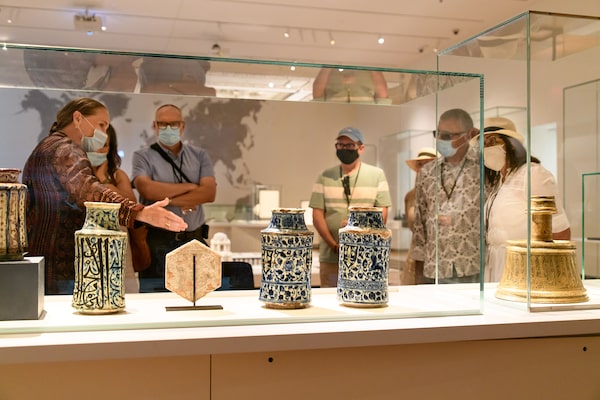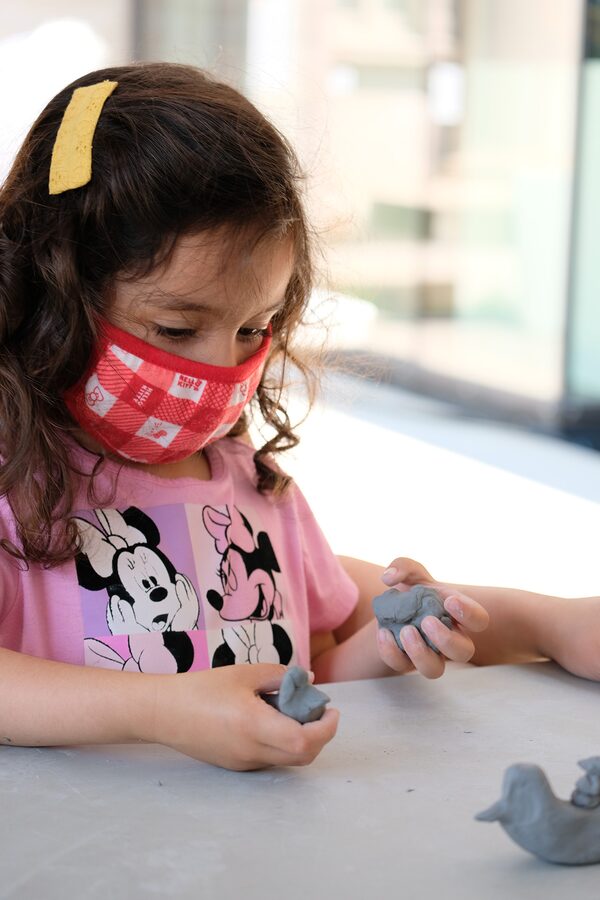
Ulrike Al-Khamis, director and CEO of the Aga Khan Museum (at left) presents some of the artworks on display at the museum. “All of our activities are designed to open minds, dispel misconceptions and grow empathetic understanding between cultures ”Alnoor Meralli
Maybe it’s because of the pandemic, but Canadians seem keener than ever to pursue knowledge and education in a myriad of forms. That applies to the arts, too, prompting organizations like museums to offer a rich array of educational programming designed to help art lovers go beyond aesthetics.
“Every artwork has a multitude of stories to tell that not only grow knowledge about their original context but also connect people with themes and ideas that everyone can appreciate,” explains Ulrike Al-Khamis, director and CEO at the Aga Khan Museum. “In that, art has the unique potential to foster intercultural empathy and understanding.”
Educational programming at the Aga Khan Museum is designed to use artworks as conversation-starters that foster reflection, critical thinking and dialogue around the arts of what is commonly called the “Muslim world” and their interconnectedness with other traditions, she notes.
The aim of the Museum Collection, comprised of more than 1,200 artworks, is to tell stories about the faith, achievements and contributions of Islamic civilizations. “All of our activities are designed to open minds, dispel misconceptions and grow empathetic understanding between cultures, using the arts as a catalyst for conversation,” Al-Khamis adds.
With the museum open again, it is gearing up for fall programming, which will feature curator-led tours of new exhibitions and the main collection, expert talks and family-focused Sundays with enriching activities for children and adults.
During the pandemic lockdown, the museum used the time to expand its resources available to schools, teachers, and post-secondary students and researchers. These include virtual and in-person tours, curriculum resources and opportunities for professional development. Inspiring life-long learning is the goal for the Aga Khan Museum.
This year, it also launched its This Being Human podcast to showcase diverse voices and redefine what it means to be Muslim today. In addition, those interested in Islamic architecture can access a free, self-paced online course that introduces key features and outstanding examples of architecture in the Muslim world.

A budding artist at the Gardiner Museum.SUPPLIED
At the Gardiner Museum, education, particularly around clay making, is always at the forefront. Visitors can take part in free family art workshops every Wednesday to Sunday until Labour Day to learn about the collection and special exhibitions, and to experiment with various art techniques under the guidance of practicing artists and educators. It also has a free audio tour (accessible through a smartphone) featuring staff members who talk about the museum’s garden, public sculptures and mini-exhibitions on display in its windows.
“We recognize that people have different comfort levels right now when it comes to a museum visit, so we’ve created programming that can be accessed inside the galleries as well as outside on the plaza,” says Nahed Mansour, curator of programs and education at the Gardiner Museum. With that in mind, the museum also offers free virtual artist talks and demonstrations that can be enjoyed from home.
Last year, it began a series called “3 Works” in which chief curator Sequoia Miller is joined by an artist to discuss three of artworks in connection to a chosen theme. Videos of those talks are archived on the Gardiner’s YouTube channel. Its popular studio classes recently restarted with reduced capacity and new health and safety measures in place.
When its new exhibition, Renaissance Venice: Life & Luxury at the Crossroads, opens in October, it will be accompanied by a suite of virtual and in-person programs, including curator and artist tours, watercolour workshops, lectures, artist demos and a special pottery class taught by acclaimed Canadian ceramist Lindsay Montgomery, whose work is featured in the exhibition.
“Through the Gardiner’s varied programming, we hope to introduce new audiences to the potential of clay and ceramics, to actively support and provide opportunities to our local maker community, and to serve as an online global resource for artists and art lovers,” says Mansour.
This fall, the McMichael Canadian Art Collection in Kleinburg continues its focus on art education through artist-led workshops – a tradition it started in 1965. On Saturdays, budding young artists can hone their skills in classes for children ages 5 to 12.
Meanwhile, adults can participate in master classes, drop-in workshops, online instruction, or receive advanced training from professional teachers. The work of students who participated in studio and master classes over the last year is being celebrated until Oct. 3 in a juried exhibition, Views from Pine Cottage.
And with Uninvited, a major exhibition highlighting women and art in the 1920s and ‘30s (opening Sept. 10), the McMichael will use the opportunity to invite art historians, curators and contemporary artists to discuss the role of women in modernism at the Canadian Women Artists Initiative Conference (Sept. 28 to Oct. 2). Programming will be available via Zoom by pre-registering. The McMichael is also hosting curatorial talks and discussions with contemporary Canadian artists through its YouTube channel.
Advertising feature produced by Globe Content Studio. The Globe’s editorial department was not involved.